Pentax SMC P-DA Fish-Eye 10-17mm f/3.5-4.5 ED Lens Review
Pentax SMC P-DA Fish-Eye 10-17mm f/3.5-4.5 ED (IF) Performance
At 10mm, sharpness isn't really the strong point of this lens. Even so, performance in the centre is very good from maximum aperture. Unfortunately the same can't be said about the performance of this lens towards the edges of the frame, which starts off poor at maximum aperture and only increases to fair levels of clarity as the lens is stopped down.At 14mm, this lens doesn’t perform much better. Centre sharpness is greatly reduced at all apertures, and the clarity recorded towards the edges of the frame isn't much better. However, stopping down to f/8 does result in outstanding sharpness in the centre of the frame.
Finally, at 17mm, sharpness in the centre improves to very good levels again at maximum aperture, and clarity towards the edges is fair. Stopping down to f/8 improves performance in the centre of the frame to outstanding levels once again, although sharpness towards the edges of the frame falls behind somewhat.
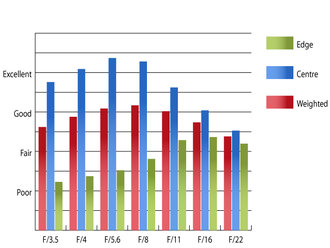 MTF@10mm | 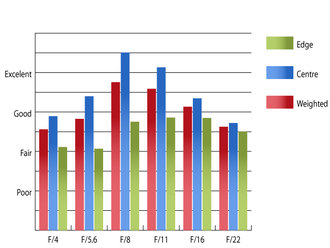 MTF@14mm |
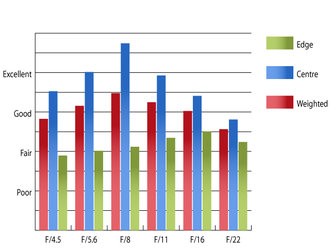 MTF@17mm | How to read our chartsThe blue column represents readings from the centre of the picture frame at the various apertures and the green is from the edges. Averaging them out gives the red weighted column.The scale on the left side is an indication of actual image resolution. The taller the column, the better the lens performance. Simple. For this review, the lens was tested on a Pentax K-5 IIs using Imatest. |
Chromatic aberrations are very high at 10mm, exceeding 2.5 pixel widths towards the edges of the frame. This level of fringing will cause problems along high contrast edges in large prints or in harsh crops from the edges of the frame.
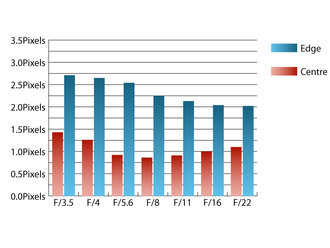 CA@10mm | 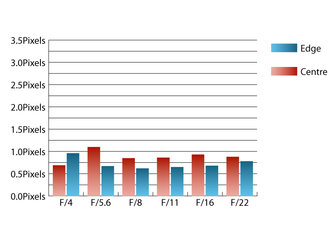 CA@14mm |
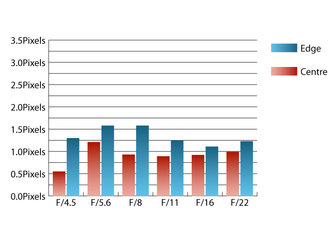 CA@17mm | How to read our chartsChromatic aberration is the lens' inability to focus on the sensor or film all colours of visible light at the same point. Severe chromatic aberration gives a noticeable fringing or a halo effect around sharp edges within the picture. It can be cured in software.Apochromatic lenses have special lens elements (aspheric, extra-low dispersion etc) to minimize the problem, hence they usually cost more. For this review, the lens was tested on a Pentax K-5 IIs using Imatest. |
Falloff of illumination is well controlled with the corners of the frame only being 1.27 stops darker than the image centre at 10mm and at 17mm the corners are 0.5 stops darker. Visually uniform illumination is achieved with the lens stopped down to f/5.6 or beyond throughout the zoom range.
Distortion is as you might expect from a fisheye. Using a fisheye lens will always be a creative choice, where the distortion is used to enhance your image.
During testing, this lens proved itself very resistant to flare and contrast stays strong, even when shooting into the light.
Add your message
Login required
Please login here or if you've not registered, you can register here. Registering is safe, quick and free.
Please login here or if you've not registered, you can register here. Registering is safe, quick and free.
photodo Stats
1102 lenses
428 MTF tests
74 in-depth photodo reviews
100+ users join each day
Help the lens community by reviewing or rating a lens today via our lens search
428 MTF tests
74 in-depth photodo reviews
100+ users join each day
Help the lens community by reviewing or rating a lens today via our lens search
Latest Lens Reviews
- Chinon 28mm f/2.8 Vintage Lens Review
- Canon EF 70-200mm f/4L IS II USM Lens Review
- Samyang AF 85mm f/1.4 EF Review
- Sigma 70mm f/2.8 DG Macro Art Review
- Samyang AF 24mm f/2.8 FE Review
- Meike 50mm f/1.7 Review
- Tamron 70-210mm f/4 Di VC USD Review
- Lensbaby Burnside 35mm f/2.8 Review
- Asahi Super Takumar 50mm f/1.4 Review
- Asahi Super-Multi-Coated Takumar 135mm f/3.5 Review
